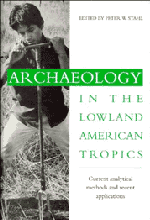Book contents
- Frontmatter
- Contents
- List of figures
- List of tables
- List of contributors
- Introduction
- 1 Archaeological survey and site discovery in the forested neotropics
- 2 The archaeology of community organization in the tropical lowlands: a case study from Puerto Rico
- 3 Archaeological methods for the study of ancient landscapes of the Llanos de Mojos in the Bolivian Amazon
- 4 Searching for environmental stress: climatic and anthropogenic influences on the landscape of Colombia
- 5 “Doing” paleoethnobotany in the tropical lowlands: adaptation and innovation in methodology
- 6 Plant microfossils and their application in the New World tropics
- 7 Differential preservation histories affecting the mammalian zooarchaeological record from the forested neotropical lowlands
- 8 Biological research with archaeologically recovered human remains from Ecuador: methodological issues
- 9 Interpreting dietary maize from bone stable isotopes in the American tropics: the state of the art
- 10 From potsherds to pots: a first step in constructing cultural context from tropical forest archaeology
- 11 Returning to Pueblo Viejo: history and archaeology of the Chachi (Ecuador)
- References
- Index
3 - Archaeological methods for the study of ancient landscapes of the Llanos de Mojos in the Bolivian Amazon
Published online by Cambridge University Press: 23 November 2009
- Frontmatter
- Contents
- List of figures
- List of tables
- List of contributors
- Introduction
- 1 Archaeological survey and site discovery in the forested neotropics
- 2 The archaeology of community organization in the tropical lowlands: a case study from Puerto Rico
- 3 Archaeological methods for the study of ancient landscapes of the Llanos de Mojos in the Bolivian Amazon
- 4 Searching for environmental stress: climatic and anthropogenic influences on the landscape of Colombia
- 5 “Doing” paleoethnobotany in the tropical lowlands: adaptation and innovation in methodology
- 6 Plant microfossils and their application in the New World tropics
- 7 Differential preservation histories affecting the mammalian zooarchaeological record from the forested neotropical lowlands
- 8 Biological research with archaeologically recovered human remains from Ecuador: methodological issues
- 9 Interpreting dietary maize from bone stable isotopes in the American tropics: the state of the art
- 10 From potsherds to pots: a first step in constructing cultural context from tropical forest archaeology
- 11 Returning to Pueblo Viejo: history and archaeology of the Chachi (Ecuador)
- References
- Index
Summary
The archaeological study of agricultural systems
Archaeological gardens and field systems are notoriously difficult to study. They tend to be “artifact poor” contexts, and thus, extremely difficult to date with accuracy. Stratigraphy tends to be heavily reworked and eroded, the result of continual cultivation and mixing of soil structure by humans and nature, both during the time of use, and after abandonment. Due to the poor preservation of botanical remains, there is usually no direct evidence for the crops which were cultivated. Technological information on cultivation practices and tools is limited, and rarely is there direct evidence for labor and social organization, land tenure, and efficiency of the system.
Ethnographic analogy can be useful in many contexts, but it is usually difficult to determine direct historical ties between contemporary farmers and their previous counterparts. In many situations, ancient field and garden systems have been completely abandoned, breaking any continuity between past and present. Even in cases where ties can be demonstrated, the social, political, economic, and environmental situation has changed so much that the usefulness of direct analogy is limited. Historical records can sometimes be extrapolated back into the past, but agricultural practices are not often discussed in sufficient detail. Despite these limitations to research, certain archaeological field methods, combined with experimental archaeology, can provide the detailed information lacking in cases where historical and ethnographic analogy is inadequate and preservation is poor.
- Type
- Chapter
- Information
- Archaeology in the Lowland American TropicsCurrent Analytical Methods and Applications, pp. 66 - 95Publisher: Cambridge University PressPrint publication year: 1995
- 38
- Cited by

